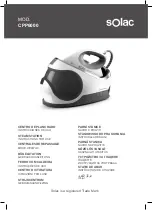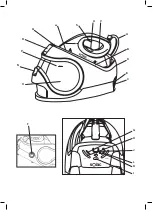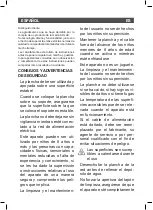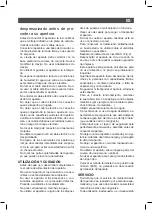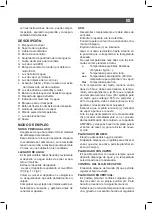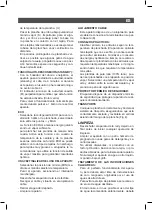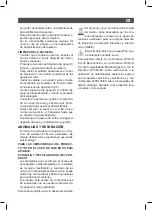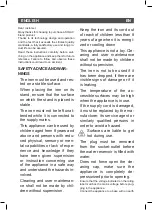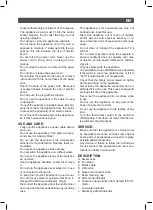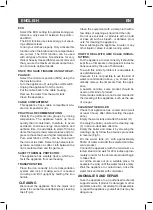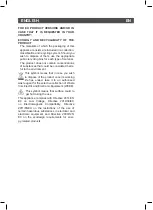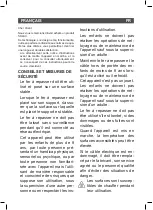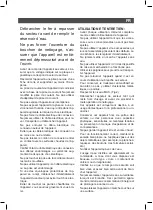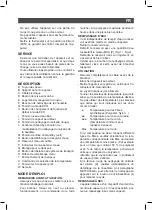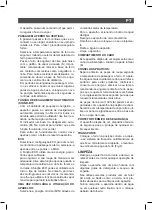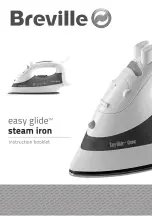
ENGLISH
EN
ECO
•
Select the ECO setting for optimal ironing per-
formance, only select it between the points ••
and MAX.
•
The ECO function uses less energy, but ensur-
ing sufficient steam
•
to iron your clothes properly. Only activate this
function when the boiler and iron temperatures
are correct. The ECO function can be used
with all types of fabrics. Nonetheless, for very
thick or heavily creased fabrics we recommend
that you use the maximum steam output func-
tion to ensure optimal results
ONCE YOU HAVE FINISHED USING THE AP-
PLIANCE:
•
Select the minimum position (MIN) using the
thermostat control.
•
Turn the appliance off, using the on/off switch.
•
Unplug the appliance from the mains.
•
Put the cable back in the cable housing. .
•
Remove the water from the water tank.
•
Clean the appliance.
CABLE COMPARTMENT
•
This appliance has a cable compartment situ-
ated on its posterior. (E)
PRACTICAL RECOMMENDATIONS:
•
Classify the garments into groups by ironing
temperature. The appliance heats up more
quickly than it cools down, therefore, to avoid
accidents, minimise energy consumption and
optimise time, it is advisable to start off ironing
items that require lower temperatures and pro-
gress to those that need higher temperatures.
•
Pure wool fabrics (100%) can be ironed with
the iron set to steam. Select a high steam tem-
perature and place a cotton cloth between the
iron’s metal surface and the garment.
SAFETY THERMAL PROTECTOR:
•
The appliance has a safety device, which pro-
tects the appliance from overheating.
TRANSPORTATION
•
Place the iron correctly into its transportation
system and lock it, making sure it is seated
correctly, and lift it upright by holding the iron
handle..
CLEANING
•
Disconnect the appliance from the mains and
allow it to cool before undertaking any cleaning
task (Fig.4).
•
Clean the equipment with a damp cloth with a
few drops of washing-up liquid and then dry.
•
Do not use solvents, or products with an acid
or base pH such as bleach, or abrasive prod-
ucts, for cleaning the appliance.
•
Never submerge the appliance in water or any
other liquid or place it under running water.
HOW TO DEAL WITH LIME SCALE INCRUS-
TATIONS:
•
For the appliance to work correctly it should be
kept free of limescale or magnesium incrusta-
tions caused by the use of hard water.
•
To avoid this kind of problem it is advisable to
use distilled water.
•
However, if it is not possible to use the kind of
water recommended above, you should peri-
odically remove the limescale from the appli-
ance.
•
A specific anti-lime scale product should be
used on this kind of product.
•
Homemade solutions are not recommended in
the decaling of this appliance, such as the use
of vinegar.
CLEANING THE BOILER
•
Check that appliance has cooled down (wait
at least 3 hours after disconnecting the appli-
ance).
•
Empty the water tank and after the boiler (O).
•
To empty the boiler, unscrew the cleaning cap
(F) in an anti-clockwise direction
•
Empty the boiler and close it by screwing the
cleaning cap by follow the previous procedure
in reverse (Fig.5).
•
Fill the water tank (O) with approximately
500ml of water and add the selected anti-lime
scale product.
•
Connect the appliance (with the maximum se-
lected steam) and wait for 20 minutes approxi-
mately in order for the anti-scale product begin
to take effect.
•
Let all the steam out (in a suitable place, for
example the sink) until the water tank is empty.
•
Wait the appliance to cooled down, rinse the
water tank and boiler with cold water.
ANOMALIES AND REPAIR
•
Take the appliance to an authorised technical
support service if product is damaged or other
problems arise. Do not attempt to disassemble
or repair the appliance yourself as this may be
dangerous.
Summary of Contents for CPP6000
Page 2: ...A B D C N P R Q w S U V O F G H I K L J E...
Page 3: ...Fig 1 Fig 3 Fig 2 Fig 4 Fig 5...
Page 58: ...BG SOLAC 8...
Page 59: ...BG 16 c MAX Fig 2 e MIN...
Page 61: ...BG S U S STAND BY stand by 8 M ECO MAX ECO ECO MIN E 100 Fig 4...
Page 62: ...BG pH 3 Fig 5 O F O 500 20 U 2014 35 UE 2014 30 UE 2011 65 U 2009 125 CE...
Page 68: ...AR 3 O F Fig 5 005 O 02 WEEE 2014 35 EU 2014 30 EU 2011 65 EU 2009 125 EC...
Page 69: ...AR U S STAND BY 8 stand by M ECO ECO MAX ECO ECO MIN E 001...
Page 70: ...AR ECO H I J K Stand L stand by M N O P Q R S T U V W MAX Fig 1 Fig 2 P J Max 04 06 J K L S...
Page 71: ...AR MAX Fig 2 MIN A B C D E F ECO G...
Page 72: ...AR SOLAC 8 8 61...

